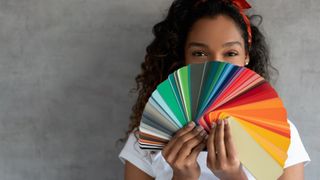
Roses are red, violets are blue, and in between are a million other hues. But which one of these colors is, statistically speaking, the most popular around the world?
It turns out that humanity's favorite hue isn't constant. A 2015 survey by YouGov found that blue was the most popular color worldwide. Meanwhile, in 2017, a survey of 30,000 people across 100 countries found deep teal to be the most popular color, The Independent reported. The answer seems to vary with the year, survey method and population sampled.
And color preferences are highly influenced by culture. For instance, a 2019 study in the journal Perception compared the favorite hues of people in Polish, Papuan and Hadza cultures. (The Hadza are a hunter-gatherer group that lives in Tanzania.) Preferred colors diverged widely among these cultures.
Related: Why is the color blue so rare in nature?
Even within the same culture, life experiences and socialization may shape color preference. For instance, in modern Western culture, blue is traditionally associated with boys, while pink is considered a "girl's color." And, unsurprisingly, a 2013 study in the journal Archives of Sexual Behavior that surveyed 749 American parents found that men tended to prefer blue while women tended to prefer red, purple and pink. This gender divide was heightened in families with only sons; in other words, men who had only sons more strongly preferred blue than did men who had girls. Meanwhile, for the Hadza, whose society is fairly egalitarian, color preferences were practically identical between men and women, the Perception study found.
The perception and categorization of colors, however, does seem to be fairly universal.
In the late 1970s, researchers with the World Color Survey undertook an incredibly broad survey of the color terms in 110 unwritten languages across the world. The objective was to test the hypothesis, articulated by American linguist Benjamin Lee Whorf in MIT Technology Review in 1940, that "we dissect nature along lines laid down by our native language. Language is not simply a reporting device for experience, but a defining framework for it."
Sign up for the Live Science daily newsletter now
Get the world’s most fascinating discoveries delivered straight to your inbox.
In other words, language shapes the perception of reality.
But that's not what the World Color Survey found. Instead, the survey found that across cultures, people tended to name hues the same way. For example, if you show people different hues that in English are clustered close to "blue," chances are that in Tagalog, Turkish or Tajik, those same hues will all be described by a word that roughly translates to "blue," too. And across cultures, speakers tend to place the boundary between foundational colors — such as red, blue, yellow and green — in roughly the same place. So the point where blue bleeds into green, or yellow into orange, was demarcated in the same places across cultures.
Originally published on Live Science on July 31, 2012, and rewritten on July 25, 2022.

Tia is the managing editor and was previously a senior writer for Live Science. Her work has appeared in Scientific American, Wired.com and other outlets. She holds a master's degree in bioengineering from the University of Washington, a graduate certificate in science writing from UC Santa Cruz and a bachelor's degree in mechanical engineering from the University of Texas at Austin. Tia was part of a team at the Milwaukee Journal Sentinel that published the Empty Cradles series on preterm births, which won multiple awards, including the 2012 Casey Medal for Meritorious Journalism.
Most Popular



